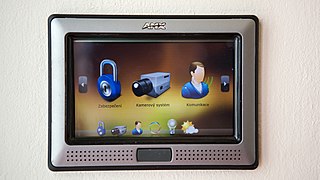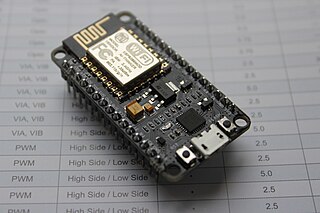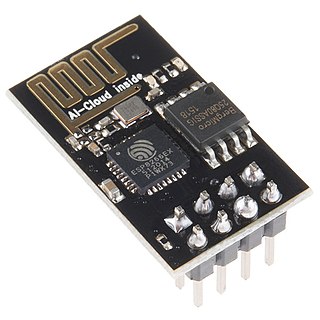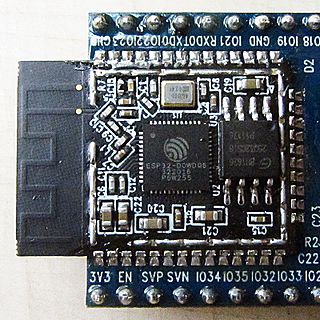
A wireless network is a computer network that uses wireless data connections between network nodes.

AVR is a family of microcontrollers developed since 1996 by Atmel, acquired by Microchip Technology in 2016. These are modified Harvard architecture 8-bit RISC single-chip microcontrollers. AVR was one of the first microcontroller families to use on-chip flash memory for program storage, as opposed to one-time programmable ROM, EPROM, or EEPROM used by other microcontrollers at the time.
Atmel Corporation was a designer and manufacturer of semiconductors before being acquired by Microchip Technology in 2016. It was founded in 1984. The company focuses on embedded systems built around microcontrollers. Its products include microcontrollers radio frequency (RF) devices including Wi-Fi, EEPROM, and flash memory devices, symmetric and asymmetric security chips, touch sensors and controllers, and application-specific products. Atmel supplies its devices as standard products, application-specific integrated circuits (ASICs), or application-specific standard product (ASSPs) depending on the requirements of its customers.
Over-the-air programming refers to various methods of distributing new software, configuration settings, and even updating encryption keys to devices like mobile phones, set-top boxes, electric cars or secure voice communication equipment. One important feature of OTA is that one central location can send an update to all the users, who are unable to refuse, defeat, or alter that update, and that the update applies immediately to everyone on the channel. A user could 'refuse' OTA, but the 'channel manager' could also 'kick them off' the channel automatically.
Insteon is a home automation (domotics) technology that enables light switches, lights, thermostats, leak sensors, remote controls, motion sensors, and other electrically powered devices to interoperate through power lines, radio frequency (RF) communications, or both. It employs a dual-mesh networking topology in which all devices are peers and each device independently transmits, receives, and repeats messages. Like other home automation systems, it has been associated with the Internet of Things.

Z-Wave is a wireless communications protocol used primarily for home automation. It is a mesh network using low-energy radio waves to communicate from appliance to appliance, allowing for wireless control of residential appliances and other devices, such as lighting control, security systems, thermostats, windows, locks, swimming pools and garage door openers. Like other protocols and systems aimed at the home and office automation market, a Z-Wave system can be controlled via the Internet from a smart phone, tablet or computer, and locally through a smart speaker, wireless keyfob, or wall-mounted panel with a Z-Wave gateway or central control device serving as both the hub controller and portal to the outside. Z-Wave provides the application layer interoperability between home control systems of different manufacturers that are a part of its alliance. There are a growing number of interoperable Z-Wave products; over 1,700 in 2017, and over 2,600 by 2019.

A sensor node, also known as a mote, is a node in a sensor network that is capable of performing some processing, gathering sensory information and communicating with other connected nodes in the network. A mote is a node but a node is not always a mote.
ONE-NET is an open-source standard for wireless networking. ONE-NET was designed for low-cost, low-power (battery-operated) control networks for applications such as home automation, security & monitoring, device control, and sensor networks. ONE-NET is not tied to any proprietary hardware or software, and can be implemented with a variety of low-cost off-the-shelf radio transceivers and micro controllers from a number of different manufacturers.
MiWi is a proprietary wireless protocol supporting peer-to-peer, star network connectivity. It was designed by Microchip Technology. MiWi uses small, low-power digital radios based on the IEEE 802.15.4 standard, and is designed for low-power, cost-constrained networks, such as industrial monitoring and control, home and building automation, remote control, wireless sensors, lighting control, and automated meter reading.

An 802.15.4 radio module is a small device used to communicate wirelessly with other devices according to the IEEE 802.15.4 protocol.

Silicon Laboratories, Inc. is a fabless global technology company that designs and manufactures semiconductors, other silicon devices and software, which it sells to electronics design engineers and manufacturers in Internet of Things (IoT) infrastructure, industrial automation, consumer and automotive markets worldwide.

OCARI is a low-rate wireless personal area networks (LR-WPAN) communication protocol that derives from the IEEE 802.15.4 standard. It was developed by the following consortium during the OCARI project that is funded by the French National Research Agency (ANR):

This is a list of home automation topics on Wikipedia. Home automation is the residential extension of building automation. It is automation of the home, housework or household activity. Home automation may include centralized control of lighting, HVAC, appliances, security locks of gates and doors and other systems, to provide improved convenience, comfort, energy efficiency and security.

NodeMCU is a low-cost open source IoT platform. It initially included firmware which runs on the ESP8266 Wi-Fi SoC from Espressif Systems, and hardware which was based on the ESP-12 module. Later, support for the ESP32 32-bit MCU was added.

The ESP8266 is a low-cost Wi-Fi microchip, with a full TCP/IP stack and microcontroller capability, produced by Espressif Systems in Shanghai, China.

MicroPython is a software implementation of a programming language largely compatible with Python 3, written in C, that is optimized to run on a microcontroller.

ESP32 is a series of low-cost, low-power system on a chip microcontrollers with integrated Wi-Fi and dual-mode Bluetooth. The ESP32 series employs a Tensilica Xtensa LX6 microprocessor in both dual-core and single-core variations and includes built-in antenna switches, RF balun, power amplifier, low-noise receive amplifier, filters, and power-management modules. ESP32 is created and developed by Espressif Systems, a Shanghai-based Chinese company, and is manufactured by TSMC using their 40 nm process. It is a successor to the ESP8266 microcontroller.
ESP Easy is a free and open source MCU firmware for the Internet of things (IoT). and originally developed by the LetsControlIt.com community. It runs on ESP8266 Wi-Fi based MCU platforms for IoT from Espressif Systems. The name "ESP Easy," by default, refers to the firmware rather than the hardware on which it runs. At a low level, the ESP Easy firmware works the same as the NodeMCU firmware and also provides a very simple operating system on the ESP8266. The main difference between ESP Easy firmware and NodeMCU firmware is that the former is designed as a high-level toolbox that just works out-of-the-box for a pre-defined set of sensors and actuators. Users simply hook up and read/control over simple web requests without having to write any code at all themselves, including firmware upgrades using OTA updates.

CircuitPython is an open-source derivative of the MicroPython programming language targeted toward students and beginners. Development of CircuitPython is supported by Adafruit Industries. It is a software implementation of the Python 3 programming language, written in C. It has been ported to run on several modern microcontrollers.
RF CMOS is a metal–oxide–semiconductor (MOS) integrated circuit (IC) technology that integrates radio-frequency (RF), analog and digital electronics on a mixed-signal CMOS RF circuit chip. It is widely used in modern wireless telecommunications, such as cellular networks, Bluetooth, Wi-Fi, GPS receivers, broadcasting, vehicular communication systems, and the radio transceivers in all modern mobile phones and wireless networking devices. RF CMOS technology was pioneered by Pakistani engineer Asad Ali Abidi at UCLA during the late 1980s to early 1990s, and helped bring about the wireless revolution with the introduction of digital signal processing in wireless communications. The development and design of RF CMOS devices was enabled by van der Ziel's FET RF noise model. It was published in the early 1960s and remained largely forgotten until the 1990s.












